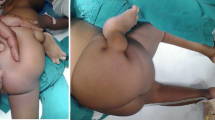Abstract
Background
Parasitic fetus is a kind of conjoined twin, in which one of the twins is resorbed and some parts of the body can remain attached to the other twin. In the spinal form of parasitic twin—the so-called parasitic rachipagus—an ectopic or accessory limb is attached to the back of a normal baby or only a mass of viable tissue may remain.
Method
Here, we report two cases of rachipagus that one had a lower extremity on her back and the other had some tissues similar to genitalia and formed bony structures on his back.


Similar content being viewed by others
References
Chadha R, Lal P, Singh D, Sharma A, Choudhury SR (2006) Lumbosacral parasitic rachipagus twin. J Pediatr Surg 41:e45–e48
Chadha R, Bagga D, Malhotra CJ, Dhar A, Kumar A (1993) Accessory limb attached to the back. J Pediatr Surg 28:1615–1617
Debnath B, Biswas SK (2011) Heteropagus twinning on back—a case report. J Indian Med Assoc 109:514–515
Jones R, Larkin FC (1889) Removal of accessory limb and meningocele from the back of a child, and its anatomy. Br Med J 2:310–311
Martinez-Frias ML, Bermejo E, Mendioroz J, Rodriguez-Pinilla E, Blanco M, Egues J et al (2009) Epidemiological and clinical analysis of a consecutive series of conjoined twins in Spain. J Pediatr Surg 44:811–820
Mutchinick OM, Luna-Munoz L, Amar E, Bakker MK, Clementi M, Cocchi G et al (2011) Conjoined twins: a worldwide collaborative epidemiological study of the International Clearinghouse for Birth Defects Surveillance and Research. Am J Med Genet C: Semin Med Genet 157C:274–287
Ratan SK, Rattan KN, Magu S, Rohilla S, Purwar P, Mathur SK (2004) Thoracolumbar rachipagus parasite. Pediatr Surg Int 20:298–300
Rode H, Fieggen AG, Brown RA, Cywes S, Davies MR, Hewitson JP et al (2010) Four decades of conjoined twins at Red Cross Children’s Hospital—lessons learned. S Afr Med J 96:931–940
Sanoussi S, Rachid S, Sani CM, Mahamane B, Addo G Rachipagus: a report of two cases - thoracic and lumbar. J Surg Tech Case Rep 2:27–29
Zhang J, Duan H, Zhang Y, Yi Z, Bao S (2011) Parasitic rachipagus conjoined twins with spina bifida, diplomyelia, scoliosis, tethered cord syndrome, and ventricular septal defect–case report. Neurol Med Chir (Tokyo) 51:736–739
Author information
Authors and Affiliations
Corresponding author
Rights and permissions
About this article
Cite this article
Navaei, A.A., Habibi, Z., Moradi, E. et al. Parasitic rachipagus twins; report of two cases. Childs Nerv Syst 31, 1001–1003 (2015). https://doi.org/10.1007/s00381-015-2664-z
Received:
Accepted:
Published:
Issue Date:
DOI: https://doi.org/10.1007/s00381-015-2664-z




